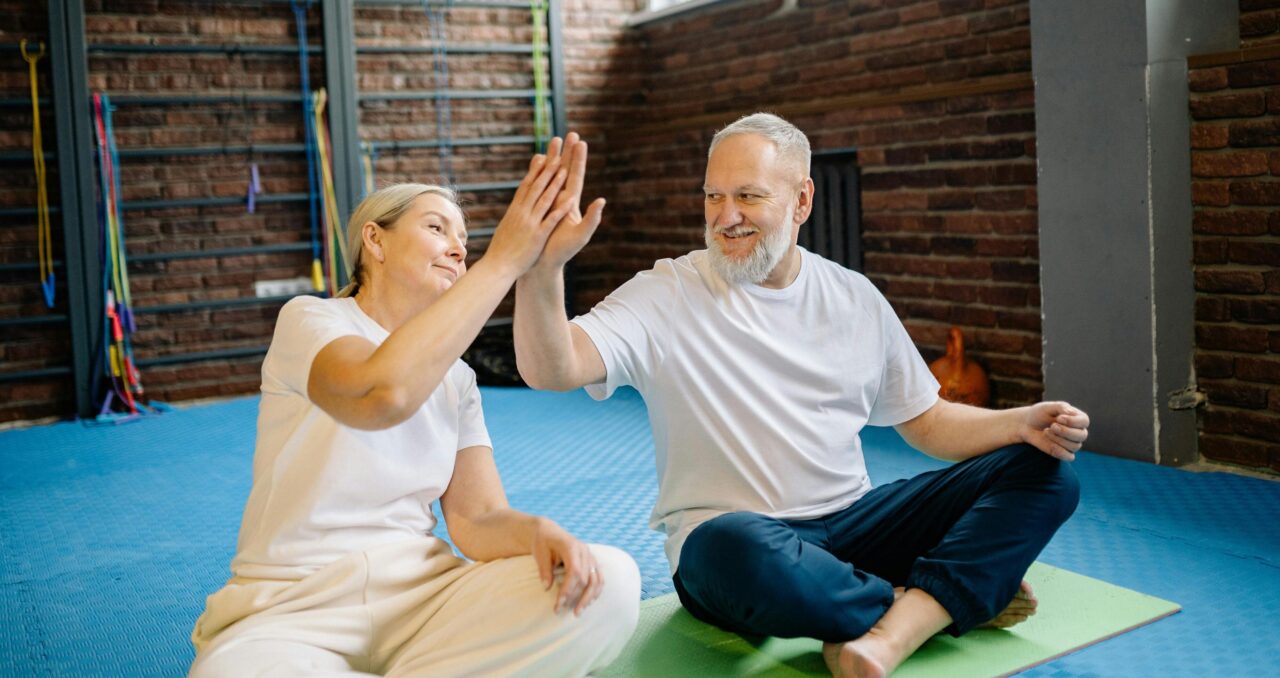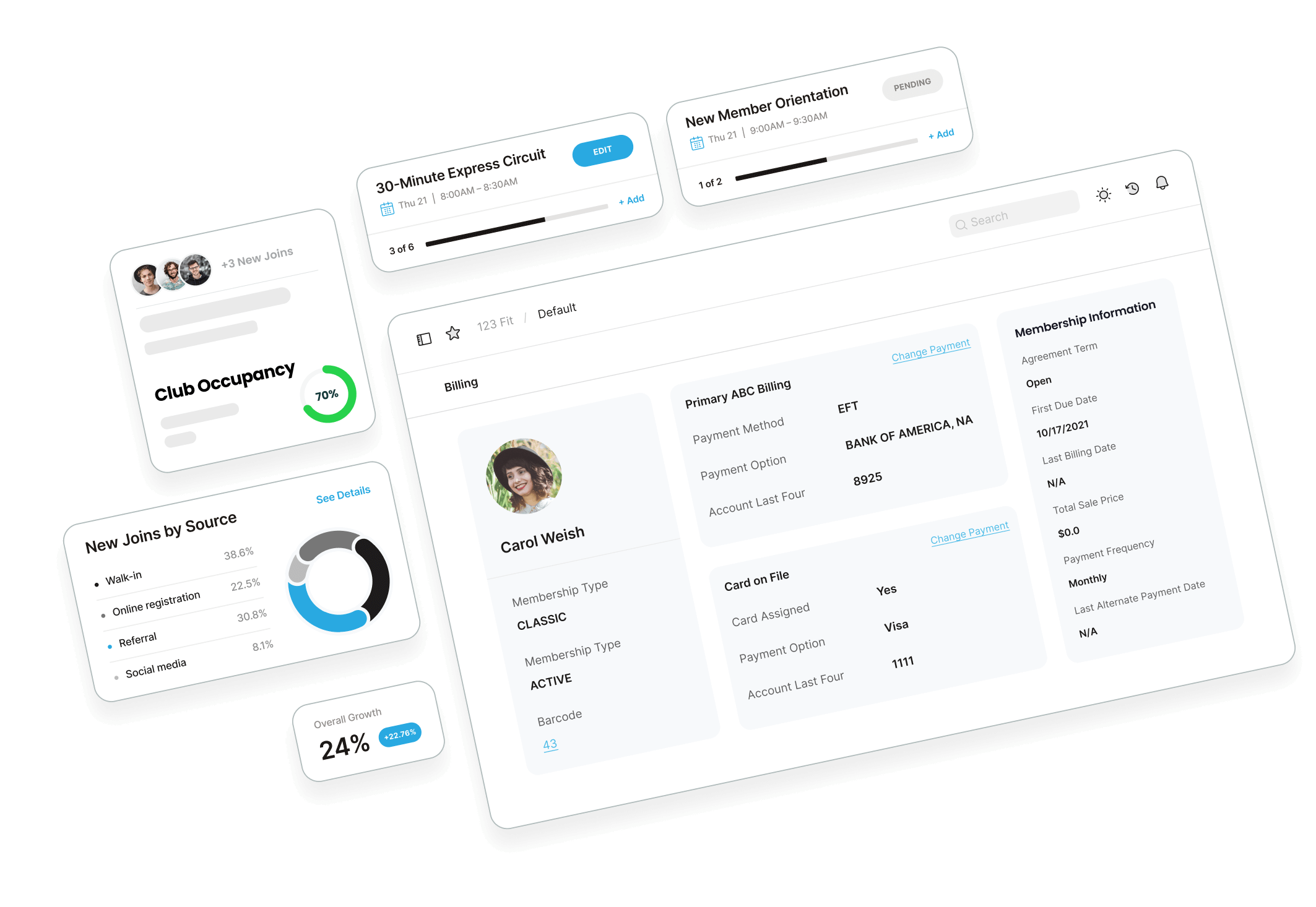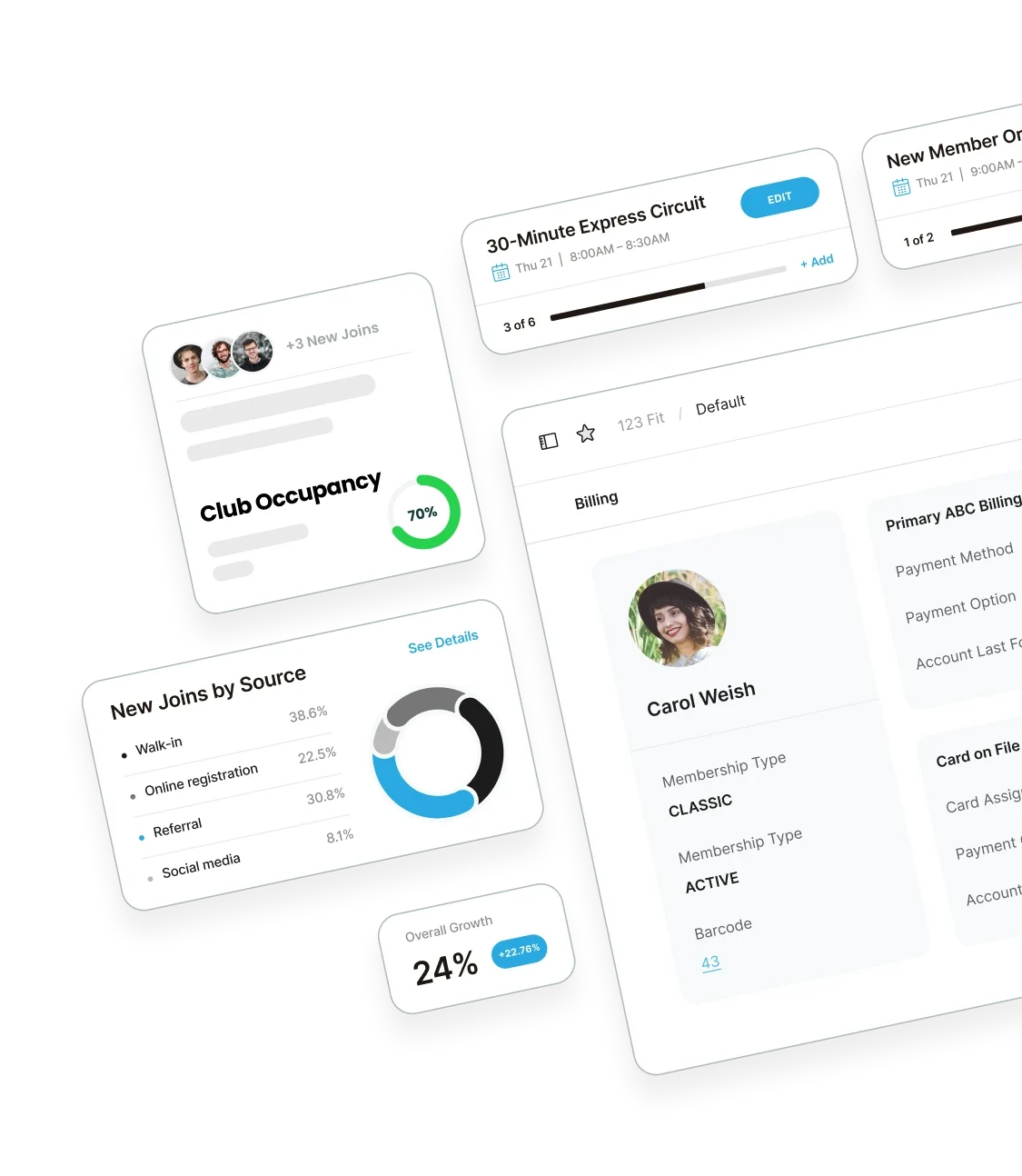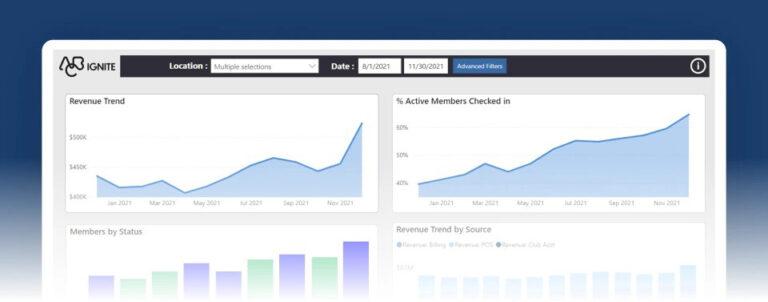In the fast-paced and ever-evolving fitness industry, understanding the diverse needs and preferences of different generations is crucial for gym owners and fitness professionals. From Baby Boomers to Gen Z, each generation has unique fitness profiles, motivations, and expectations when it comes to their gym experience.
That’s why ABC Ignite partnered with ClubIntel to conduct a national study among active consumers in 2024. By identifying life stages and segmenting our respondents accordingly, we were able to analyze how physical activity and fitness behaviors vary across different generations.
This helped to identify patterns and trends in consumer behavior related to physical activity, fitness, and wellness across different stages of life. It also revealed insights such as which generations are most likely to engage in certain types of physical activities and how spending on fitness-related products and services varies.
In this guide, we’ll dive into effective marketing strategies to attract and retain members across these different age groups, ensuring that your gym remains relevant and appealing to every generation.
Active Consumers and Their Fitness Profiles
In this study, active consumers were asked to select their age ranges. These ranges may not perfectly match the generational ages typically used in research. Instead, they serve as approximate ranges to understand the behavior of each generation.
Below is a table showing the general segments and how our study’s age ranges correspond to them.

To better understand the behaviors of fitness enthusiasts, we also segmented our respondents into four different categories:
- Wellness Lovers
- Fitness Explorers
- Routine Lifers
- Casual Consumers
There are two clear patterns with Fitness Profiles as members age. Between the stages of being a Millennial (28-43 years old) and becoming a Gen X (44-59 years old), a shift happens with fitness profiles where the Routine Lifer segment starts growing significantly. This growth within the Routine Lifer segment continues with Baby Boomers and beyond.
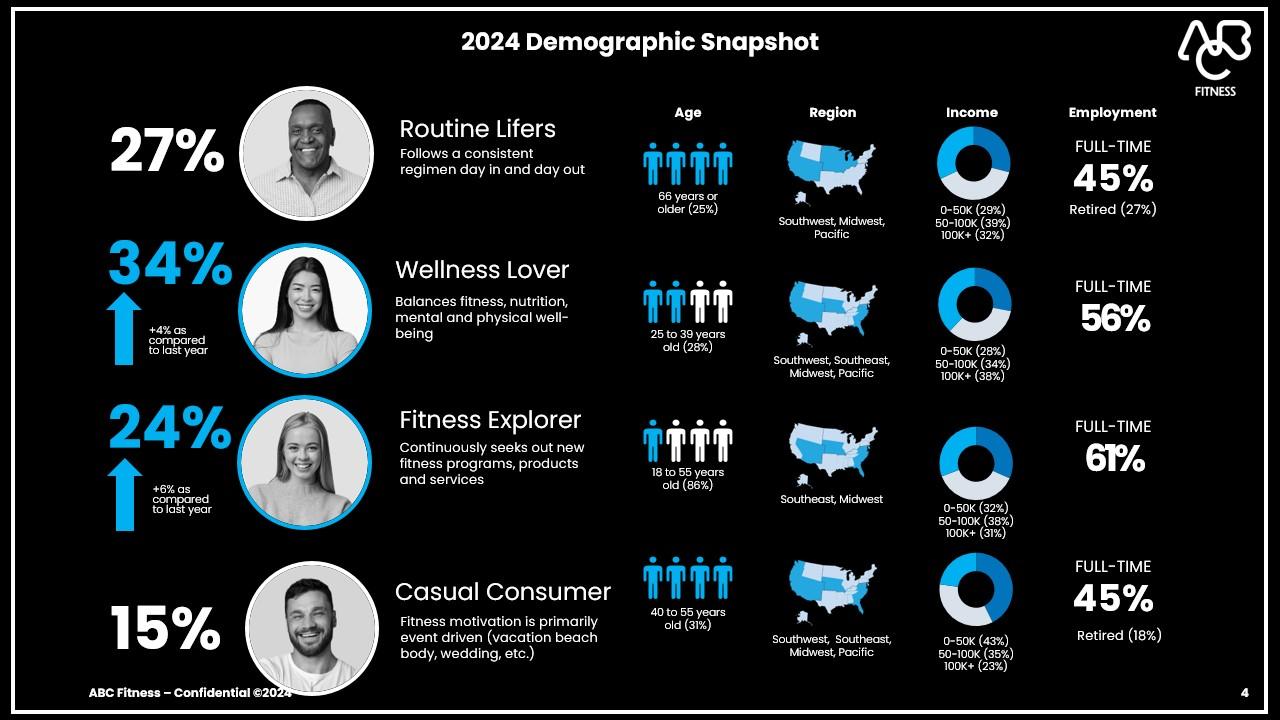
With that said, Fitness Explorers are the dominant segment for Gen Z, which decreases as one ages (possibly shifting to a Routine Lifer). Those who are Wellness Lovers tend to remain constant from generation to generation.
Get insight from our 2024 active consumer study and find out what member trends to tap into for this year and beyond. Download the full eBook here.
Generational Values
Every generation is shaped by various life events and behaviors that shape their values. These factors include technological advancements during their lifetime, the political landscape, and major events such as the COVID-19 pandemic, war, etc.
The following list presents the primary values for each generation, drawn from extensive research conducted by McKinsey & Company, Pew Research, and other reputable sources.

This list isn’t completely exhaustive, but these values represent the key factors influencing decision-making and behaviors within each generation.
Understanding Each Generation’s Fitness Preferences
Exercise Modalities:
Certain exercise modalities have broad appeal regardless of age such as exercising outside and using fitness equipment at home. However, some modalities appeal more to a younger audience including digital-only programs, free online fitness, studios, sports activities, and in-person personal training.
The Gen Z Fitness Consumer
Discover more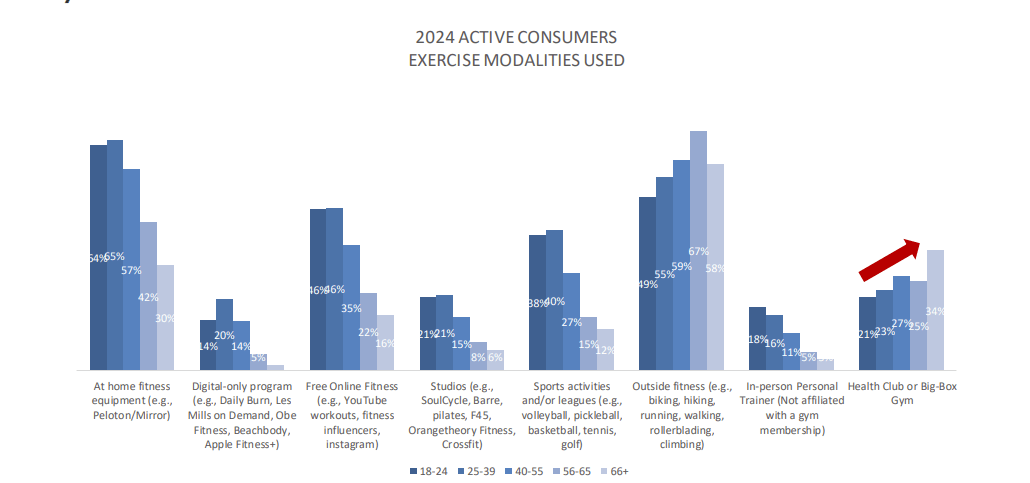
Although traditional health clubs/big-box gyms capture a smaller share of use than exercising at home and outside, its appeal tends to grow with age, making it the top modality for those who are 66+ years old.
Fitness Goals:
As people age, their goals tend to shift from losing weight, having a vacation beach body, and/or being in shape for an athletic sport to simply just wanting to be active. This is seen early on, usually once someone reaches their mid-20s.

All age ranges claim to be effectively meeting their fitness goals. Once someone reaches their 40s, there’s a dip in goal achievement, indicating an opportunity to provide guidance and support.

Monthly Spend:
Those who are Baby Boomers and older spend the least on monthly exercise expenses, with approximately 60% and more falling into the “Less than $25” spend range.
Despite their lower income, Gen Z report spending between $25 and $74 a month, while Millennials are higher than average in the $75-$150 range.

Millennials and Gen Z, major fitness spenders, are getting married, with 2.1 million weddings yearly averaging over $28,000. Seize this opportunity and download our recent guide, Effective Gym Marketing Campaigns for Wedding Season, for tailored marketing campaigns.
How to Market Your Gym to Each Generation
Generation Z (Ages 18-24): Tech-Savvy and Socially Conscious
Gen Z, born between 1997 and 2012, is the first generation to grow up entirely in the digital age.

To effectively connect with Gen Z, gym owners should consider the following strategies:
- Digital Presence: Gen Z is highly digital-native, so having a strong online presence is crucial. This includes maintaining active social media profiles on platforms like Instagram, TikTok, and Snapchat, where Gen Z spends a significant amount of time. Regularly posting engaging content such as workout tips, success stories, and behind-the-scenes glimpses can help capture their attention.
- Personalization: Gen Z values personalized experiences, so consider tailoring your offerings to cater to individual preferences and goals. This could involve offering personalized workout plans, nutrition advice, and goal tracking through mobile apps or digital platforms.
- Community Engagement: Gen Z is drawn to communities and social causes. Create a sense of community by organizing group fitness classes, social events, and charity initiatives. Encouraging members to connect both in-person and online fosters a sense of belonging and loyalty.
- Technology Integration: Leveraging technology is essential for appealing to Gen Z. Incorporate wearable fitness trackers, virtual reality workouts, and interactive fitness apps into your offerings to provide a modern and engaging experience.
- Flexibility and Convenience: Gen Z values flexibility and convenience in their lifestyles. Offer flexible membership options, such as pay-per-use or monthly subscriptions, and provide amenities like 24/7 access, online class streaming, and mobile booking capabilities.
- Authenticity and Transparency: Gen Z appreciates authenticity and transparency from brands. Be genuine in your messaging and practices, emphasizing factors like sustainability, inclusivity, and diversity. Being transparent about pricing, membership terms, and facility amenities also builds trust with this generation.
- Innovative Programming: Gen Z craves novelty and innovation. Differentiate your gym by offering unique and cutting-edge fitness programs, such as high-intensity interval training (HIIT), functional fitness classes, and boutique-style workout experiences.
- Digital Presence: Gen Z is highly digital-native, so having a strong online presence is crucial. This includes maintaining active social media profiles on platforms like Instagram, TikTok, and Snapchat, where Gen Z spends a significant amount of time. Regularly posting engaging content such as workout tips, success stories, and behind-the-scenes glimpses can help capture their attention.
- Social Responsibility: Gen Z is socially conscious and values businesses that demonstrate corporate social responsibility. Align your gym with causes that resonate with this generation, such as promoting mental health awareness, supporting eco-friendly initiatives, or partnering with local charities.
Unlock more insights into Gen Z in our comprehensive eBook, co-created by ABC Fitness and Les Mills. Download now to learn from the experts and supercharge your Gen Z engagement strategy.
Millennials (Ages 25-39): Digital Natives and Experience Seekers
Millennials, born between 1981 and 1996, are digital natives who value experiences and social connections.

To effectively position your gym to Millennials, consider their unique preferences and priorities:
- Emphasize Convenience and Flexibility: Millennials often have busy schedules, so offering flexible membership options and convenient hours of operation can be a significant selling point. Consider extending operating hours, providing online booking for classes and facilities, and offering virtual workout options for those who prefer to exercise from home.
- Focus on Community and Social Engagement: Millennials value experiences and connections with others. Create a welcoming and inclusive atmosphere where members can connect with like-minded individuals. Organize social events, group fitness classes, and challenges to foster a sense of community within the health club.
- Highlight Technological Integration: Millennials are digital natives and appreciate technology that enhances their fitness experience. Invest in state-of-the-art equipment with integrated apps and tracking capabilities. Offer virtual training sessions, personalized workout plans through mobile apps, and digital progress tracking tools to appeal to their tech-savvy nature.
- Promote Holistic Wellness: Millennials prioritize overall well-being, including mental, emotional, and physical health. Position your gym as a holistic wellness destination by offering services beyond traditional fitness, such as yoga classes, meditation sessions, nutrition counseling, and wellness workshops.
- Incorporate Sustainability Practices: Millennials are environmentally conscious and are more likely to support businesses that prioritize sustainability. Implement eco-friendly initiatives within the health club, such as energy-efficient equipment, recycling programs, and sustainable building materials. Communicate your commitment to sustainability in your marketing materials to resonate with environmentally conscious Millennials.
- Offer Personalization and Customization: Millennials appreciate personalized experiences tailored to their individual preferences and goals. Offer personalized fitness assessments, consultations with trainers, and customized workout plans to meet the unique needs of each member. Use data analytics to track member preferences and behaviors, allowing you to offer targeted recommendations and promotions.
- Leverage Social Media and Influencer Marketing: Millennials are active users of social media platforms and often rely on peer recommendations when making purchasing decisions. Use social media channels to showcase your gym’s offerings, share member success stories, and engage with your audience in meaningful conversations. Partner with fitness influencers or local celebrities to extend your reach and credibility within the Millennial demographic.
Generation X (Ages 40-55): Busy Lifestyles and Results-Oriented Training
Gen X, born between 1965 and 1980, is known for their busy lifestyles and sensible approach to fitness.

To effectively market to Gen X, consider the following:
- Emphasize Efficiency and Results: Gen Xers often juggle multiple responsibilities, including careers and family obligations. Position your gym as a place where they can maximize their workout efficiency and achieve tangible results. Highlight time-saving workout programs, HIIT classes, and effective strength training routines that deliver visible progress in a short amount of time.
- Cater to Busy Lifestyles: Recognize that Gen Xers have hectic schedules and limited free time. Offer flexible membership options, extended operating hours, and express workout options for those who need to fit exercise into their busy schedules. Provide on-the-go amenities such as grab-and-go healthy snacks, convenient locker rooms, and childcare services to accommodate their lifestyle needs.
- Promote Stress Reduction and Work-Life Balance: Gen Xers often prioritize work-life balance and stress management. Position your club as a sanctuary where they can escape from the demands of daily life and recharge both mentally and physically. Consider offering stress-relieving amenities such as sauna and steam rooms, meditation classes, and relaxing spa treatments to help them unwind.
- Focus on Functional Fitness and Longevity: Gen Xers are increasingly concerned about maintaining their health and mobility as they age. Highlight functional fitness programs that focus on improving strength, flexibility, and mobility to support active and independent living in the long term. Offer specialized classes and workshops on injury prevention, joint health, and age-appropriate exercise techniques.
- Provide Family-Friendly Options: Many Gen Xers are parents and may appreciate family-friendly offerings that allow them to prioritize their health while also engaging in activities with their children. Offer family membership packages, kid-friendly fitness classes, and supervised play areas for children to create a welcoming environment for families.
- Leverage Technology for Convenience: Gen Xers are comfortable with technology and appreciate its convenience. Offer online booking systems, mobile workout tracking apps, and virtual fitness classes to provide flexibility and convenience for members who prefer digital solutions. Leverage social media platforms to engage with Gen Xers and showcase the club’s offerings and community.
- Create a Sense of Camaraderie and Connection: Gen Xers value relationships and connections with others. Foster a sense of camaraderie within the health club by organizing group challenges, social events, and networking opportunities. Encourage members to support and motivate each other, creating a supportive community that extends beyond the gym walls.
Baby Boomers (Ages 56-66+): Active Aging and Personalized Attention
Baby Boomers, born between 1946 and 1964, represent a significant demographic for the fitness industry. As they age, many Boomers prioritize staying active and maintaining their health and vitality.

When positioning offerings to Baby Boomers, it’s important to emphasize elements that cater to their unique needs and preferences. Here are some recommendations:
- Prioritize Health and Wellness: Baby Boomers are usually focused on maintaining their health and vitality as they age. Position your gym as a place where they can achieve their fitness goals, improve mobility, and enhance overall well-being. Offer specialized programs and classes tailored to older adults, such as low-impact exercises, senior fitness classes, and targeted strength training routines.
- Highlight Safety and Comfort: Baby Boomers may have concerns about safety and comfort while exercising. Ensure that your fitness environment is welcoming, accessible, and equipped with amenities such as handrails, non-slip flooring, and comfortable seating areas. Hire knowledgeable staff trained to assist older adults and address their specific needs and concerns.
- Offer Flexibility and Variety: Recognize that Baby Boomers have diverse interests and fitness levels. Offer a variety of exercise options, including group fitness classes, aqua aerobics, yoga, and walking clubs, to cater to different preferences and abilities. Provide flexible membership options that allow Baby Boomers to participate in activities that suit their schedule and lifestyle.
- Provide Educational Resources: Baby Boomers value learning and self-improvement. Offer educational workshops, seminars, and informational sessions on topics such as nutrition, injury prevention, stress management, and healthy aging. Empower them with knowledge and resources to make informed decisions about their health and wellness journey.
- Foster a Sense of Community: Baby Boomers appreciate opportunities for social interaction and connection. Create a supportive and inclusive community within the health club where members can build friendships, share experiences, and motivate each other. Organize social events, coffee mornings, and group outings to foster camaraderie and a sense of belonging.
- Embrace Technology with Caution: While some Baby Boomers are tech-savvy, others may be less comfortable with digital tools and platforms. Offer technology-based amenities such as fitness tracking apps and online scheduling platforms but ensure that they are user-friendly and accompanied by sufficient support and guidance for those who need assistance.
- Provide Personalized Support and Guidance: Baby Boomers may benefit from personalized attention and guidance from fitness professionals. Offer individualized assessments, personal training sessions, and ongoing support to help them set and achieve their fitness goals safely and effectively. Encourage a collaborative approach where members feel empowered to take control of their health with the guidance of knowledgeable professionals
Stay Ahead of the Pack with Gym Management Software
Tailoring your gym’s approach to cater to different generations ensures better member attraction and retention. Whether it’s personalization, immersive experiences, or embracing technology, adapting your marketing efforts maintains your competitive advantage.
ABC Ignite’s software offers a comprehensive view of your gym’s performance, helping you to make empowering, data-backed decisions. From managing clubs to revenue cycles and mobile experiences, ABC Ignite streamlines workflows, boosts engagement, and helps you grow your fitness business with confidence.
